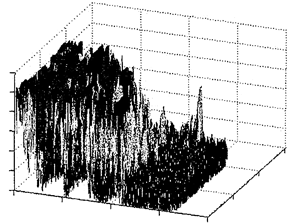Method of forming classified training sample in case of spacial signal processing under influence of combined interference
DOI:
https://doi.org/10.3103/S0735272718070051Keywords:
radar signal processing, adaptive spatial filtering, combined interference, classified training sample, normalized autocorrelation function, functional schemeAbstract
Under the conditions of the combined interference, the operation efficiency of the radar equipment is substantially deteriorated. This is due to the decorrelation of the signals of the point source of active interference acting on the radar by passive interference. In this article methods of formation of the classified training sample, generated only by active interference, are considered for adaptation of the weight coefficients of spatial filters under conditions of combined interference presence. An effective method of forming the classified training sample generated by active masking interference was developed for spatial processing of radar signals under conditions of simultaneous exposure to passive interference. The developed method of forming the training sample is based on estimating the width of the normalized autocorrelation function in each element of the distance resolution. The current analysis of the combined interference components in each resolution element improves the quality of the interference component classification and, as a result, minimizes the effect of passive interference on the adaptation process of the spatial filter. The theoretical and practical aspects of the formation of the classified training sample are considered. The functional scheme of the classifier for the combined interference components is developed. The efficiency of the proposed method is compared with known correlation methods. The current analysis of the combined interference components in each element of the range resolution improves the quality of interference classification, which is important in the context of complex hydrometeorological conditions.References
- ANDREJEV, V.G.; NGUYEN, T.P. “Adaptive processing of signals on a background of clutter and noise,” Radioelectron. Commun. Syst., v.58, n.2, p.85-89, 2015. DOI: https://doi.org/10.3103/S0735272715020053.
- PIZA, D.M.; ZVIAHINTSEV, Y.A.; MOROZ, G.V. “Method of compensating the active component of combined interference in coherent pulse radar,” Radioelectron. Commun. Syst., v.59, n.6, p.251-255, 2016. DOI: https://doi.org/10.3103/S0735272716060030.
- SHIRMAN, Y.D. (ed.), Radioelectronic Systems: Design Fundamentals and Theory, 2nd extended ed. [in Russian]. Moscow: Radiotekhnika, 2007.
- RIABUKHA, V.P.; RACHKOV, D.S.; SEMENIAKA, A.V.; KATIUSHYN, Y.A. “Estimation of spatial weight vector fixation interval for sequential space-time signal processing against the background of combined interferences,” Radioelectron. Commun. Syst., v.55, n.10, p.443-451, 2012. DOI: https://doi.org/10.3103/S0735272712100020.
- WIDROW, B.; STEARNS, S.D. Adaptive Signal Processing. Prentice-Hall, Inc., 1985.
- IVLEV, D.N.; ORLOV, I.Y.; SOROKINA, A.V.; FITASOV, Y.S. Adaptive Algorithms of Interference Compensation [in Russian]. Nizhny Novgorod: Lobachevsky State University of Nizhny Novgorod, 2014.
- PIZA, D.M.; SIRENKO, A.S. “Protection method of coherent-pulse radars from combined interferences,” UA Patent 78120, IPC G01S 7/36. Zaporizhzhya National Technical University, submitted 28.08.2012; published Bull. Izobr., n.5, 2013.
- PIZA, D.M.; LAVRENTIEV, V.N.; SEMENOV, D.S. “Method of forming of the classified training sample for automatic canceller of the interferences when using time-space filtering of signals,” Radioelectronics, Computer Science, Control, n.3, p.18-22, 2016. DOI: https://doi.org/10.15588/1607-3274-2016-3-2.
- GONOROVSKIY, I.S. Radioengineering Circuits and Signals [in Russian]. Moscow: Sov. Radio, 1977.
- LEKHOVYTSKIY, D.I.; RIABUKHA, V.P.; ZHUGA, G.A. “Tracking of moving targets in impulse radars: 1. Physical meaning and extremal properties of optimal inter-period processing of Gaussian signals in the background of Gaussian passive interference,” Applied Radioelectronics, v.10, n.10, p.463-478, 2011.

Downloads
Published
2018-07-30
Issue
Section
Research Articles

